The changes that have taken place in the workplace in recent years have impacted the world of the modern learner. The rapid evolution of technology and workplace demographic shifts are just the tip of the iceberg. To get the most out of your organization's learners, it's key to recognize how you can best sharpen their talent in today's climate.
Factors hindering the modern learner
To give the modern learner the resources they need to succeed, we must first understand what's slowing them down. For one thing, people get distracted very easily. According to a Bersin by Deloitte study, most people are interrupted an average of once every five minutes and browse the internet as much as 27 times a day. This lack of focus can be overwhelming. In fact, two-thirds of today's workforce simply doesn't have time to get their jobs done.
Plus, in this day and age, people are impatient. If online materials don't grab a person's attention within 15 seconds, they'll move on, reports Time. People want critical information delivered in a way that is short and to the point. When given a choice, most won't watch a video for more than four minutes.
Adopting new strategies
The challenge becomes breaking out of past thinking. The question is where to start? Here are some ideas.
1. Allow for time
As people discover freedom on the job, workplaces need to empower people to allow for uninterrupted time for professional development. Employees told Deloitte they spend only 1% of their time during the workweek on training and development—a mere 24 minutes a week! And continuous interruptions interrupt and shrink that sliver of dedication to professional development. Allow—and encourage—people to designate time in their calendars, not for more meetings, but for learning.
2. Provide relevant material
Adult learners appreciate immediate relevancy as this helps them to be more productive on the job. Because of this, content and context then become critical to any learning design. Reaching the hearts and minds of people in the learning process provides an important personal connection to the material. Whenever possible, engage your learners emotionally or connect new information with past experiences. Without relevance, people disengage and lose motivation.
3. Make learning accessible
Learning occurs everywhere. The modern classroom isn't a place—it's an experience. Make learning available in the flow of work, and put it where people can find it with microlearning and other chunked content. People need to view content without stepping away from the job. According to Bersin by Deloitte, about 80% of workforce learning "happens via on-the-job interactions with peers, teammates, and managers," meaning learning is an increasingly collaborative activity within the workplace.
4. Understand that people really want to learn
Often, we assume people don't want to learn new things, when in fact the opposite is true. According to LinkedIn's "2018 Workplace Learning Report," 94% of employees will remain at a company that invests in their professional development. However, only 15% of people have access to the learning they need when they need it. That's a big disconnect.
People inherently know that learning is critical to improving and sustaining relevance in the workplace. With the right content, people are open to the new ideas and opportunities that learning brings.
Helping the modern learner
People are eager to learn. They want to enrich their personal and professional lives. Understanding the challenges faced in the modern workplace can help you connect employees with relevant, resonant information to enable their continued success.





